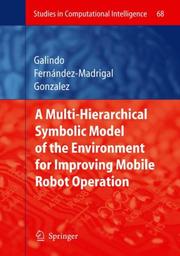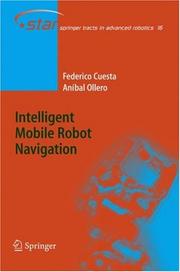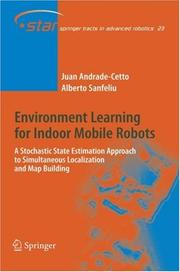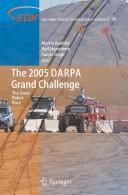| Listing 1 - 8 of 8 |
Sort by
|

ISBN: 012185230X 0080511716 Year: 1990 Volume: 5 Publisher: New York, NY ; London : Academic Press,
Abstract | Keywords | Export | Availability | Bookmark
 Loading...
Loading...Choose an application
- Reference Manager
- EndNote
- RefWorks (Direct export to RefWorks)
Book
ISBN: 9780262015356 9780262295321 0262295326 0262015358 Year: 2011 Publisher: Cambridge, Massachusetts [Piscataqay, New Jersey] MIT Press IEEE Xplore
Abstract | Keywords | Export | Availability | Bookmark
 Loading...
Loading...Choose an application
- Reference Manager
- EndNote
- RefWorks (Direct export to RefWorks)
Mobile robots range from the Mars Pathfinder mission's teleoperated Sojourner to the cleaning robots in the Paris Metro. This text offers students and other interested readers an introduction to the fundamentals of mobile robotics, spanning the mechanical, motor, sensory, perceptual, and cognitive layers the field comprises. The text focuses on mobility itself, offering an overview of the mechanisms that allow a mobile robot to move through a real world environment to perform its tasks, including locomotion, sensing, localization, and motion planning. It synthesizes material from such fields as kinematics, control theory, signal analysis, computer vision, information theory, artificial intelligence, and probability theory. The book presents the techniques and technology that enable mobility in a series of interacting modules. Each chapter treats a different aspect of mobility, as the book moves from low-level to high-level details. It covers all aspects of mobile robotics, including software and hardware design considerations, related technologies, and algorithmic techniques.] This second edition has been revised and updated throughout, with 130 pages of new material on such topics as locomotion, perception, localization, and planning and navigation. Problem sets have been added at the end of each chapter. Bringing together all aspects of mobile robotics into one volume, Introduction to Autonomous Mobile Robots can serve as a textbook or a working tool for beginning practitioners.
Mobile robots --- Autonomous robots --- 007.52 --- 681.3*I29 --- robots. automaten --- Robotics: manipulators; propelling mechanisms; sensors (Artificial intelli- gence) --- Autonomous robots. --- Mobile robots. --- 681.3*I29 Robotics: manipulators; propelling mechanisms; sensors (Artificial intelli- gence) --- Robots --- Autonomous robotic systems --- Robots mobiles. --- Robots autonomes. --- Classical mechanics. Field theory --- Artificial intelligence. Robotics. Simulation. Graphics --- mobiliteit --- robots

ISBN: 9783540726883 3540726888 9786610955459 1280955457 354072690X Year: 2007 Publisher: Berlin, Heidelberg ; New York : Springer,
Abstract | Keywords | Export | Availability | Bookmark
 Loading...
Loading...Choose an application
- Reference Manager
- EndNote
- RefWorks (Direct export to RefWorks)
This book focuses on the efficient performance of mobile robots through the use of multi-hierarchical symbolic representations of the environment. A mobile robot intended to perform deliberative actions must possess some symbolic representation of its workspace, but such representations of real environments usually become so large that should be conveniently arranged in order to facilitate and, in some cases, make possible their use. Apart from the drawback of dealing with large amounts of information, other problems stand out when using symbolic representations. One is keeping the model properly optimized with respect to the robot tasks while maintaining it coherent with reality. Another one is the creation (or modification) of symbols from sensorial data. This book addresses all these issues considering symbolic multi-hierarchical structures. Such structures, based on the concept of abstraction, allow a robot to speed up its operation in large environments. Practical solutions tested on real robots (for instance, a robotic wheelchair for elder people) are provided. The book is intended for PhD students and in general for robotics, computer science, and artificial intelligence researchers.
Mobile robots. --- Robots mobiles --- Mobile robots --- Mechanical Engineering - General --- Mechanical Engineering --- Engineering & Applied Sciences --- Engineering. --- Artificial intelligence. --- Applied mathematics. --- Engineering mathematics. --- Control engineering. --- Robotics. --- Mechatronics. --- Control, Robotics, Mechatronics. --- Appl.Mathematics/Computational Methods of Engineering. --- Artificial Intelligence (incl. Robotics). --- Robots --- Mathematical and Computational Engineering. --- Artificial Intelligence. --- AI (Artificial intelligence) --- Artificial thinking --- Electronic brains --- Intellectronics --- Intelligence, Artificial --- Intelligent machines --- Machine intelligence --- Thinking, Artificial --- Bionics --- Cognitive science --- Digital computer simulation --- Electronic data processing --- Logic machines --- Machine theory --- Self-organizing systems --- Simulation methods --- Fifth generation computers --- Neural computers --- Engineering --- Engineering analysis --- Mathematical analysis --- Mathematics --- Mechanical engineering --- Microelectronics --- Microelectromechanical systems --- Automation --- Control engineering --- Control equipment --- Control theory --- Engineering instruments --- Programmable controllers

ISBN: 3540239561 9783540239567 3540315071 Year: 2005 Volume: 16 Publisher: Berlin, Heidelberg : Springer Berlin Heidelberg : Imprint: Springer,
Abstract | Keywords | Export | Availability | Bookmark
 Loading...
Loading...Choose an application
- Reference Manager
- EndNote
- RefWorks (Direct export to RefWorks)
Intelligent Mobile Robot Navigation builds upon the application of fuzzy logic to the area of intelligent control of mobile robots. Reactive, planned and teleoperated techniques are considered, leading to the development of novel fuzzy control systems for perception and navigation of nonholonomic autonomous vehicles. The unique feature of this monograph lies in its comprehensive treatment of the problem from the theoretical development of the various schemes down to the real-time implementation of algorithms on mobile robot prototypes. As such, the book spans across different domains ranging from mobile robots to intelligent transportation systems, from automatic control to artificial intelligence.
Artificial intelligence. Robotics. Simulation. Graphics --- Computer. Automation --- robots --- navigatie --- fuzzy logic --- Robots --- Mobile robots --- Robots mobiles --- Control --- Engineering. --- Artificial intelligence. --- Vibration. --- Control Engineering. --- Automation and Robotics. --- Artificial Intelligence (incl. Robotics). --- Vibration, Dynamical Systems, Control. --- Mechanical Engineering - General --- Mechanical Engineering --- Engineering & Applied Sciences --- Information Technology --- Artificial Intelligence --- AI (Artificial intelligence) --- Artificial thinking --- Electronic brains --- Intellectronics --- Intelligence, Artificial --- Intelligent machines --- Machine intelligence --- Thinking, Artificial --- Construction --- Dynamical systems. --- Dynamics. --- Control engineering. --- Robotics. --- Mechatronics. --- Automation. --- Robotics and Automation. --- Control, Robotics, Mechatronics. --- Artificial Intelligence. --- Cycles --- Mechanics --- Sound --- Bionics --- Cognitive science --- Digital computer simulation --- Electronic data processing --- Logic machines --- Machine theory --- Self-organizing systems --- Simulation methods --- Fifth generation computers --- Neural computers --- Dynamical systems --- Kinetics --- Mathematics --- Mechanics, Analytic --- Force and energy --- Physics --- Statics --- Mechanical engineering --- Microelectronics --- Microelectromechanical systems --- Control engineering --- Control equipment --- Control theory --- Engineering instruments --- Automation --- Programmable controllers --- Automatic factories --- Automatic production --- Computer control --- Engineering cybernetics --- Factories --- Industrial engineering --- Mechanization --- Assembly-line methods --- Automatic control --- Automatic machinery --- CAD/CAM systems --- Robotics

ISBN: 9783540327950 3540327959 3540328483 Year: 2006 Volume: v. 23 Publisher: Berlin, Heidelberg : Springer Berlin Heidelberg : Imprint: Springer,
Abstract | Keywords | Export | Availability | Bookmark
 Loading...
Loading...Choose an application
- Reference Manager
- EndNote
- RefWorks (Direct export to RefWorks)
This monograph covers theoretical aspects of simultaneous localization and map building for mobile robots, such as estimation stability, nonlinear models for the propagation of uncertainties, temporal landmark compatibility, as well as issues pertaining the coupling of control and SLAM. One of the most relevant topics covered in this monograph is the theoretical formalism of partial observability in SLAM. The authors show that the typical approach to SLAM using a Kalman filter results in marginal filter stability, making the final reconstruction estimates dependant on the initial vehicle estimates. However, by anchoring the map to a fixed landmark in the scene, they are able to attain full observability in SLAM, with reduced covariance estimates. This result earned the first author the EURON Georges Giralt Best PhD Award in its fourth edition, and has prompted the SLAM community to think in new ways to approach the mapping problem. For example, by creating local maps anchored on a landmark, or on the robot initial estimate itself, and then using geometric relations to fuse local maps globally. This monograph is appropriate as a text for an introductory estimation-theoretic approach to the SLAM problem, and as a reference book for people who work in mobile robotics research in general. Juan Andrade Cetto holds a BSEE degree from CETYS University, 1993; an MSEE degree from Purdue University, 1995; and a doctorate from the Technical University of Catalonia, 2003. He is currently with the Institut the Robòtica i Informàtica Industrial, CSIC-UPC. Alberto Sanfeliu received the BSEE and PhD degrees from the Technical University of Catalonia in 1978 and 1982, respectively. He joined the UPC faculty in 1981, and is since 1984, Professor with the Systems Engineering Department, for which he was appointed Head in 2005. Dr. Sanfeliu is also affiliated to the Institut the Robòtica i Informàtica Industrial, CSIC-UPC. His current research areas are Pattern Recognition, Computer Vision, and Robotics. He is Fellow of IAPR.
Mobile robots --- Kalman filtering --- Robots --- Robots mobiles --- Kalman, filtrage de --- Control systems --- Systèmes de commande --- Engineering. --- Artificial intelligence. --- Computer vision. --- Automation and Robotics. --- Control Engineering. --- Artificial Intelligence (incl. Robotics). --- Computer Imaging, Vision, Pattern Recognition and Graphics. --- Mechanical Engineering - General --- Mechanical Engineering --- Engineering & Applied Sciences --- Information Technology --- Artificial Intelligence --- AI (Artificial intelligence) --- Artificial thinking --- Electronic brains --- Intellectronics --- Intelligence, Artificial --- Intelligent machines --- Machine intelligence --- Thinking, Artificial --- Construction --- Machine vision --- Vision, Computer --- Computer graphics. --- Control engineering. --- Robotics. --- Mechatronics. --- Control. --- Control, Robotics, Mechatronics. --- Bionics --- Cognitive science --- Digital computer simulation --- Electronic data processing --- Logic machines --- Machine theory --- Self-organizing systems --- Simulation methods --- Fifth generation computers --- Neural computers --- Industrial arts --- Technology --- Mechanical engineering --- Microelectronics --- Microelectromechanical systems --- Automation --- Control engineering --- Control equipment --- Control theory --- Engineering instruments --- Programmable controllers --- Automatic drafting --- Graphic data processing --- Graphics, Computer --- Computer art --- Graphic arts --- Engineering graphics --- Image processing --- Digital techniques --- Control and Systems Theory. --- Artificial Intelligence. --- Artificial intelligence --- Pattern recognition systems --- Optical data processing. --- Optical computing --- Visual data processing --- Integrated optics --- Photonics --- Computers --- Optical equipment

ISBN: 9783540728078 3540728074 9786610969890 128096989X 3540728082 Year: 2007 Publisher: Berlin, Germany ; New York, New York : Springer,
Abstract | Keywords | Export | Availability | Bookmark
 Loading...
Loading...Choose an application
- Reference Manager
- EndNote
- RefWorks (Direct export to RefWorks)
Walking is simple for most of us, but two-legged robots (bipeds) are often slow, complex, inefficient, heavy, and have robotic-looking motions. What makes human walking so graceful? Can this be replicated with human-like robots? Martijn Wisse and Richard Q. van der Linde provide a detailed description of their research on pneumatic biped robots at the Delft University of Technology, The Netherlands. The book covers the basic theory - passive dynamic walking - and explains the implementation of pneumatic McKibben muscles in a series of successful prototypes.
Mobile robots. --- Robots --- Bipedalism. --- Pneumatic machinery. --- Robots mobiles --- Motion. --- Mouvements --- Robots -- Motion. --- Mobile robots --- Bipedalism --- Pneumatic machinery --- Mechanical Engineering --- Engineering & Applied Sciences --- Mechanical Engineering - General --- Motion --- Information Technology --- Artificial Intelligence --- Bipedal locomotion --- Bipedal posture --- Bipedal walking --- Bipedality --- Bipedalization --- Posture, Bipedal --- Upright walking --- Walking, Bipedal --- Walking, Upright --- Movement of robots --- Robot motion --- Engineering. --- Artificial intelligence. --- System theory. --- Control engineering. --- Robotics. --- Mechatronics. --- Control, Robotics, Mechatronics. --- Artificial Intelligence (incl. Robotics). --- Systems Theory, Control. --- Mechanical engineering --- Microelectronics --- Microelectromechanical systems --- Automation --- Machine theory --- Control engineering --- Control equipment --- Control theory --- Engineering instruments --- Programmable controllers --- Systems, Theory of --- Systems science --- Science --- AI (Artificial intelligence) --- Artificial thinking --- Electronic brains --- Intellectronics --- Intelligence, Artificial --- Intelligent machines --- Machine intelligence --- Thinking, Artificial --- Bionics --- Cognitive science --- Digital computer simulation --- Electronic data processing --- Logic machines --- Self-organizing systems --- Simulation methods --- Fifth generation computers --- Neural computers --- Construction --- Industrial arts --- Technology --- Philosophy --- Fluid power technology --- Machinery --- Human beings --- Locomotion --- Attitude and movement --- Systems theory. --- Artificial Intelligence.

ISSN: 1610742X ISBN: 9783540734284 3540734287 3540734295 Year: 2007 Volume: v. 36 Publisher: Heidelberg Springer
Abstract | Keywords | Export | Availability | Bookmark
 Loading...
Loading...Choose an application
- Reference Manager
- EndNote
- RefWorks (Direct export to RefWorks)
At the dawn of the new millennium, robotics is undergoing a major transformation in scope and dimension. From a largely dominant industrial focus, robotics is rapidly expanding into the challenges of unstructured environments. Interacting with, assi- ing, serving, and exploring with humans, the emerging robots will increasingly touch people and their lives. The goal of the new series of Springer Tracts in Advanced Robotics (STAR) is to bring, in a timely fashion, the latest advances and developments in robotics on the basis of their significance and quality. It is our hope that the wider dissemination of research developments will stimulate more exchanges and collaborations among the research community and contribute to further advancement of this rapidly growing field. The volume edited by Martin Buehler, Karl Iagnemma and Sanjiv Singh presents a unique and extensive collection of the scientific results by the teams which took part into the DARPA Grand Challenge in October 2005 in the Nevada desert. This event reached an incredible peak of popularity in the media, the race of the century like someone called it! The Grand Challenge demonstrated the fast growing progress - ward the development of robotics technology, as it showed the feasibility of using mobile robots operating autonomously in real world scenarios.
Motor vehicles --- Mobile robots --- Robots mobiles --- Automatic control --- Automotive Engineering --- Mechanical Engineering --- Engineering & Applied Sciences --- Information Technology --- Artificial Intelligence --- Mobile robots. --- Automatic control. --- Automotive vehicles --- Engineering. --- Artificial intelligence. --- System theory. --- Machinery. --- Control engineering. --- Robotics. --- Mechatronics. --- Control, Robotics, Mechatronics. --- Artificial Intelligence (incl. Robotics). --- Machinery and Machine Elements. --- Systems Theory, Control. --- Mechanical engineering --- Microelectronics --- Microelectromechanical systems --- Automation --- Machine theory --- Control engineering --- Control equipment --- Control theory --- Engineering instruments --- Programmable controllers --- Machinery --- Machines --- Manufactures --- Power (Mechanics) --- Technology --- Motors --- Power transmission --- Systems, Theory of --- Systems science --- Science --- AI (Artificial intelligence) --- Artificial thinking --- Electronic brains --- Intellectronics --- Intelligence, Artificial --- Intelligent machines --- Machine intelligence --- Thinking, Artificial --- Bionics --- Cognitive science --- Digital computer simulation --- Electronic data processing --- Logic machines --- Self-organizing systems --- Simulation methods --- Fifth generation computers --- Neural computers --- Construction --- Industrial arts --- Curious devices --- Philosophy --- Robots --- Transportation, Automotive --- Vehicles --- Systems theory. --- Artificial Intelligence. --- Robots. --- Automata --- Automatons --- Robotics --- Manipulators (Mechanism) --- Mecha (Vehicles)
Book
ISBN: 9783540782865 3540782869 3540782877 Year: 2008 Volume: v. 43 Publisher: Berlin, Heidelberg : Springer-Verlag,
Abstract | Keywords | Export | Availability | Bookmark
 Loading...
Loading...Choose an application
- Reference Manager
- EndNote
- RefWorks (Direct export to RefWorks)
Rough terrain robotics is a fast evolving field of research and a lot of effort is deployed towards enabling a greater level of autonomy for outdoor vehicles. This book demonstrates how the accuracy of 3D position tracking can be improved by considering rover locomotion in rough terrain as a holistic problem. Although the selection of appropriate sensors is crucial to accurately track the rover’s position, it is not the only aspect to consider. Indeed, the use of an unadapted locomotion concept severely affects the signal to noise ratio of the sensors, which leads to poor motion estimates. In this work, a mechanical structure allowing smooth motion across obstacles with limited wheel slip is used. In particular, it enables the use of odometry and inertial sensors to improve the position estimation in rough terrain. A method for computing 3D motion increments based on the wheel encoders and chassis state sensors is developed. Because it accounts for the kinematics of the rover, this method provides better results than the standard approach. To further improve the accuracy of the position tracking and the rover’s climbing performance, a controller minimizing wheel slip is developed. The algorithm runs online and can be adapted to any kind of passive wheeled rover. Finally, sensor fusion using 3D-Odometry, inertial sensors and visual motion estimation based on stereovision is presented. The experimental results demonstrate how each sensor contributes to increase the accuracy and robustness of the 3D position estimation.
Mobile robots --- Robots --- Robots mobiles --- Control systems --- Systèmes de commande --- Mechanical Engineering - General --- Mechanical Engineering --- Engineering & Applied Sciences --- Information Technology --- Artificial Intelligence --- Mobile robots. --- Control systems. --- Robot control --- Engineering. --- Artificial intelligence. --- System theory. --- Control engineering. --- Robotics. --- Mechatronics. --- Automation. --- Robotics and Automation. --- Control, Robotics, Mechatronics. --- Artificial Intelligence (incl. Robotics). --- Systems Theory, Control. --- Automatic factories --- Automatic production --- Computer control --- Engineering cybernetics --- Factories --- Industrial engineering --- Mechanization --- Assembly-line methods --- Automatic control --- Automatic machinery --- CAD/CAM systems --- Robotics --- Mechanical engineering --- Microelectronics --- Microelectromechanical systems --- Automation --- Machine theory --- Control engineering --- Control equipment --- Control theory --- Engineering instruments --- Programmable controllers --- Systems, Theory of --- Systems science --- Science --- AI (Artificial intelligence) --- Artificial thinking --- Electronic brains --- Intellectronics --- Intelligence, Artificial --- Intelligent machines --- Machine intelligence --- Thinking, Artificial --- Bionics --- Cognitive science --- Digital computer simulation --- Electronic data processing --- Logic machines --- Self-organizing systems --- Simulation methods --- Fifth generation computers --- Neural computers --- Construction --- Industrial arts --- Technology --- Philosophy --- Systems theory. --- Artificial Intelligence.
| Listing 1 - 8 of 8 |
Sort by
|

 Search
Search Feedback
Feedback About UniCat
About UniCat  Help
Help News
News